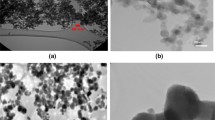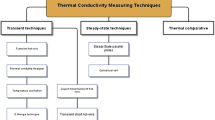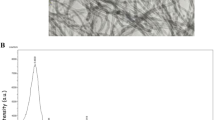Abstract
In this study, convective heat transfer performance of a nanofluids containing graphite is studied in an industrial microchannel. In the experiments, initially, to prepare nanofluids at the volume fraction values of 0.5, 1, 1.5, 2%, distilled water has been employed as the base liquid. To provide sedimentation and stabilization of nanofluids in distilled water, Cetyltrimethylammonium bromide (CTAB) is utilized as surfactant. Thermophysical properties of nanofluids such as thermal conductivity, dynamic viscosity, and specific heat are determined experimentally. Furthermore, by building an experimental setup, in the temperature range of 20–30 °C and with temperature intervals of 2 °C, performance experiments are carried out in a microchannel of which hydraulic diameter is 1.6 × 10−3 m. Additionally, experiments have been conducted using nanofluids at different volumetric rates from 1 to 7 l min−1, heat fluxes from 100 to 1100 W, and volume fractions from 0.5 to 2%. Measuring heat flux, temperature, and flow rate, outcomes such as convective heat transfer coefficient, Reynolds number, and Nusselt number are calculated. The validation process of the experimental results has been performed by plotting the figures of Nusselt numbers vs Reynolds ones, and heat transfer coefficient vs supplied heat considering distilled water and nanofluids having various volumetric proportions. Regarding with the performance of nanofluids against distilled water under similar operating conditions, some proportional positive increase are acquired. Using outcomes attained from experiments, new correlations for Nusselt number have been derived with the R2 values around 0.96, and afterward by means of those correlations experimental data have been compared with those in the literature. A large number of measured and calculated data are given in the paper for other researchers to validate their theoretical models.










Similar content being viewed by others
Change history
21 August 2020
The affiliation of the sixth author
Abbreviations
- m:
-
Volumetric flow rate (lt min−1)
- μ:
-
Dynamic viscosity (kg m−1 s−1)
- Ac :
-
Fin cross sectional area (m2)
- CMOS:
-
Complementary metal oxide semiconductor
- cp :
-
Specific heat at constant pressure (J kg−1 K−1)
- D:
-
Circular diameter (m)
- Dh :
-
Hydraulic diameter (m)
- g:
-
Gravitational constant (m s−2)
- G:
-
Mass flow (kg m−2 s−1)
- h:
-
Convection heat transfer coefficient (W m−2 K−1)
- Hch :
-
Channel height (m)
- Hfin :
-
Fin height (m)
- I:
-
Current (Amper)
- k:
-
Thermal conductivity coefficient (W m−1 K−1)
- k:
-
Heat transfer coefficient of the fin material (W m−1 K−1)
- Lch :
-
Micro channel length (m)
- MAPE:
-
Mean absolute percent error (%)
- MCHS:
-
Microchannel heat exchanger
- MEMS:
-
Micro electro-mechanical systems
- MEPCM:
-
Micro encapsulated phase change material
- N:
-
Number of channels
- P:
-
Electrical power (W)
- p:
-
Fin element circumference (m)
- R:
-
Electrical resistance (Ω)
- Pr:
-
Prandtl number
- Re:
-
Reynolds number
- SDy :
-
Standard deviation of the dependent variable
- SDx1 :
-
Standard deviation value of variable x1
- SDx2 :
-
Standard deviation value of variable x2
- QT :
-
Total heat power (kW)
- qw :
-
Heat flux (kW m−2)
- Ts :
-
Surface temperature (°C)
- U:
-
uncertainty
- V:
-
Voltage (Volt)
- Wch :
-
Channel thickness (m)
- Wfin :
-
Fin thickness (m)
- δtc :
-
Distance from thermocouple to the channel base (m)
- Y:
-
Multiple regression equation
- η:
-
Fin efficiency
- ρ:
-
Density (kg m−3)
- σs :
-
Surface tension in water capillary pipes (N m−1)
- φ:
-
Volume fraction of nanofluid (%)
- tC :
-
Thermocouple
- vol:
-
Volume fraction
- x 1 :
-
Independent variable for vol [%] Volume Fraction
- x 2 :
-
Independent variable for reynolds Number
- x 3 :
-
Independent variable for prandtl Number
- x 4 :
-
Independent variable for dynamic viscosity of liquid
- c:
-
Constant number
- r y, x1 :
-
Correlation between x1 and y.
- r y, x2 :
-
Correlation between x2 and y.
- r x1, x2 :
-
Correlation between x1 and x2.
- β 1 :
-
The change in Y for each 1 increment change in x1
- β 2 :
-
The change in Y for each 1 increment change in x2
- β 3 :
-
The change in Y for each 1 increment change in x3
- β 4 :
-
The change in Y for each 1 increment change in x4
- ave:
-
Average
- b:
-
Base
- Ch:
-
Channel
- cor:
-
Correlation
- exp:
-
Experimental
- f:
-
Liquid
- h:
-
Power
- nf:
-
Nanofluids
- T:
-
Total
References
Tuckerman DB, Pease RFW (1981) High–performance heat sinking for VLSI, IEEE Electron. Device Letters, EDL-2, 126–129
Wu HY, Cheng P (2003) An experimental study of convective heat transfer in silicon microchannels with different surface conditions. Int J Heat Mass Transf 46:2547–2556
Lee PS, Garimella SV, Liu D (2005) Investigation of heat transfer in rectangular microchannels. Int J Heat Mass Transf 48:1688–1704
Baviere R, Favre-Marinet M, Person SL (2006) Bias effects on heat transfer measurements in microchannel flows. Int J Heat Mass Transf 49:3325–3337
Shen S, Xu JL, Zhou JJ, Chen Y (2006) Flow and heat transfer in microchannels with rough wall surface. Energy Convers Manag 47:1311–1325
Wei X, Joshi Y (2007) Experimental and numerical study of sidewall profile effects on flow and heat transfer inside microchannels. Int J Heat Mass Transf 50:4640–4651
Park HS, Punch J (2008) Friction factor and heat transfer in multiple microchannels with uniform flow distribution. Int J Heat Mass Transf 51:4535–4543
Jung JY, Oh HS, Kwak HY (2009) Forced convective heat transfer of nanofluids in microchannels. Int J Heat Mass Transf 52:466–472
Ergu BO, Sara ON, Yapıcı S, Arzutug ME (2009) Pressure drop and point mass transfer in a rectangular microchannel. International Communications in Heat and Mass Transfer 36:618–623
Garcia-Hernando N, Acosta-Iborra A, Ruiz-Rivas U, Izquierdo M (2009) Experimental investigation of fluid flow and heat transfer in a single-phase liquid flow. Int J Heat Mass Transf 52:5433–5446
Chiu HC, Jang JH, Yeh HW, Wu MS (2011) The heat transfer characteristics of liquid cooling heatsink containing microchannels. Int J Heat Mass Transf 54:34–42
Mohammadpoor M, Sabbaghi S, Zerafat MM, Manafi Z (2019) Investigating heat transfer properties of copper nanofluid in ethylene glycol synthesized through single and two-step routes. Int J Refrig 99:243–250
Sarafraz MM, Arjomandi M (2018) Demonstration of plausible application of gallium nano-suspension in microchannel solar thermal receiver: Experimental assessment of thermohydraulic performance of microchannel. International Communications in Heat and Mass Transfer 94:39–46
Esmaili Q, Ranjbar AA, Porkhial S (2018) Experimental analysis of heat transfer in ribbed microchannel. Int J Therm Sci 130:140–147
Dong S, Jiang H, Xie Y, Wang X, Hu Z, Wang J (2019) Experimental investigation on boiling heat transfer characteristics of Al2O3-water nanofluids in swirl microchannels subjected to an acceleration force. Chin J Aeronaut
Zhao N, Qi C, Chen T, Tang J, Cui X (2019) Experimental study on influences of cylindrical grooves on thermal efficiency, exergy efficiency and entropy generation of CPU cooled by nanofluids. Int J Heat Mass Transf 135:16–32
Ho CJ, Liao JC, Li CH, Yan WM, Amani M (2019) Experimental study of cooling performance of water-based alumina nanofluid in a minichannel heat sink with MEPCM layer embedded in its ceiling. International Communications in Heat and Mass Transfer 103:1–6
Bowers J, Cao H, Qiao G, Li Q, Zhang G, Mura E, Ding Y (2018) Flow and heat transfer behaviour of nanofluids in microchannels. Progress in Natural Science: Materials International 28:225–234
Simsek E, Coskun S, Ozyurt TO, Unalan HE (2018) Heat transfer enhancement by silver nanowire suspensions in microchannel heat sinks. Int J Therm Sci 123:1–13
Foo ZH, Cheng KX, Goh AL, Ooi KT (2018) Single-phase convective heat transfer performance of wavy microchannels in macro geometry. Appl Therm Eng 141:675–687
Sarafraz MM, Nikkhah V, Nakhjavani M, Arya A (2018) Thermal performance of a heat sink microchannel working with biologically produced silver-water nanofluid: Experimental assessment. Exp Thermal Fluid Sci 91:509–519
Yiamsawasd T, Dalkilic AS, Wongwises S (2012) Measurement of the thermal conductivity of titania and alumina nanofluids. Thermochim Acta 545:48–56
Thiangtham P, Keepaiboon C, Kiatpachai P, Asirvatham LG, Mahianc O, Dalkilic AS, Wongwises S (2016) An experimental study on two-phase flow patterns and heat transfercharacteristics during boiling of R134a flowing through a multi-microchannel heat sink. Int J Heat Mass Transf 98:390–400
Kline SJ, McClintock FA (1953) Describing uncertainties in single sample experiments. Mech Eng 75:3–8
Kakac S, Pramuanjaroenkij A (2009) Review of convective heat transfer enhancement with nanofluids. Int J Heat Mass Transf 52:3187–3196
Sajadi AR, Kazemi MH (2011) Investigation of turbulent convective heat transfer and pressure drop of TiO2/water nanofluid in circular tube. International Communications in Heat and Mass Transfer 38:1474–1478
Wu P, Little WA (1083) Measurement of friction factors for the flow of gases in very fine channels used for microminiature refrigerators. Cryogenics 24:273–277
Choi SB, Barron RF, Warrington RO (1991) Fluid flow and heat transfer in microtubes, Micromech. Sensors Actuators Systems ASME DSC 32:123–134
Yu D, Warrington R, Barron R, Ameel T (1995) An experimental and theoretical investigation of fluid flow and heat transfer in microtubes. Proceedings of ASME/JSME Thermal Engineering Joint Conference 1:523–530
Wang XL, Zhou P, Peng XF (2003) A fractal model for predicting the effective thermal conductivity of liquid with suspension of nanoparticles. Int J Heat Mass Transf 46:2665–2672
Nguyen CT, Gilles R, Christian G, Nicolas G (2007) Heat transfer enhancement using Al2O3-water nanofluid for an electronic liquid cooling system. Appl Therm Eng 27:1501–1506
Dittus FW, Boelter LMK (1930) Heat transfer in automobile radiator of the tubular type. University of California at Berkley Publication. Engineering 2:443–461
Hausen H (1943) Darstellung des warmeuberganges in Rohren durch verallge meinerte Potenzbeziehungen. Z VDI Beihefte Verfahrenstechnik 4:91–98
Gnielinski V (1976) New equations for heat and mass transfer in turbulent pipe and channel flow. Int Chem Eng 16:359–368
Kakac S, Shah RK, Aung W (1987) Handbook of Single – Phase Convective Heat Transfer. John Wiley and Sons, New York
Philips RJ (1987) Forced convection liquid cooled microchannel heat sinks, Msc. Thesis. Massachusetts Institute of Technology, Boston
Churchill SW, W S, Bernstein M (1977) A correlating equation for forced convection from gases and liquids to a circular cylinder in crossflow. ASME Journal of Heat Transfer 99:300–306
Asirvathama LG, Rajab B, Lal DM, Wongwises S (2011) Convective heat transfer of nanofluids with correlations. Particuology 9:626–631
Pak BC, Cho YI (1998) Hydrodynamic and heat transfer study of dispersed fluids with submicron metallic oxide particles. Experimental Heat Transfer 11:151–170
Sundar LS, Singh MK (2013) Convective heat transfer and friction factor correlations of nanofluid in a tube and with inserts: a review. Renew Sust Energ Rev 20:23–35
Vajjha RS, Das DK, Kulkarni DP (2010) Development of new correlations for convective heat transfer and friction factor in turbulent regime for nano- fluids. Int J Heat Mass Transf 53:4607–4618
Madhesh D, Parameshwaran R, Kalaiselvam S (2014) Experimental investigation on convective heat transfer and rheological characteristics of Cue TiO2 hybrid nanofluids. Exp Thermal Fluid Sci 52:104–115
Nasrin R, Alim MA (2014) Semi-empirical relation for forced convective analysis through a solar collector. Sol Energy 105:455–467
Shah RK, London AL (1978) Laminar Flow Forced Convection in Ducts, Supplement 1 to Advances in Heat Transfer. Academic Press, New York
Stephan K, Preußer P (1979) Warmeübergang und maximale warmestromdichte beim behaltersieden binarer und ternarer flüssigkeitsgemische. Chemie Ingenieur Technik 23:73–87
Jiang PX, Fan MH, Si GS, Ren ZP (2001) Thermal-hydraulic performance of small scale micro-channel and porous-media heat exchangers. Int J Heat Mass Transf 44:1039–1051
Xuan Y, Li Q, Hu W (2003) Aggregation Structure and Thermal Conductivity of Nanofluids. AICHE J 49:1038–1043
Suresh S, Venkitaraj KP, Selvakumar P, Chandrasekar M (2012) Effect of Al2O3-Cu/water hybrid nanofluid in heat transfer. Exp Thermal Fluid Sci 38:54–60
Moraveji MK, Esmaeili E (2012) Comparison between single-phase and two phases CFD modeling of laminar forced convection flow of nanofluids in a circular tube under constant heat flux. International Communications in Heat Mass Transfer 39:1297–1302
Morini GL (2006) 2006, Scaling Effects for Liquid Flows in Microchannels. Heat Transfer Engineering 27:64–73
Dalkiliç AS, Mahian O, Yılmaz S, Sakamatapan K, Wongwises S (2017) Experimental investigation of single-phase turbulent flow of R-134a in a multiport microchannel heat sink. International Communications in Heat Mass Transfer 89:47–56
Tafarroj MM, Mahian O, Kasaeian A, Sakamatapan K, Dalkiliç AS, Wongwises S (2017) Artificial neural network modeling of nanofluid flow in a microchannel heat sink using experimental data. International Communications in Heat Mass Transfer 86:25–31
Keepaiboon C, Thiangtham P, Mahian O, Dalkiliç AS, Wongwises S (2016) Pressure drop characteristics of R134a during flow boiling in a single rectangular micro-channel. International Communications in Heat Mass Transfer 71:245–253
Thiangtham P, Keepaiboon C, Kiatpachai P, Asirvatham LG, Mahian O, Dalkiliç AS (2016) An experimental study on two-phase flow patterns and heat transfer characteristics during boiling of R134a flowing through a multi-microchannel heat sink. Int J Heat Mass Transf 98:390–400
Nitiapiruk P, Mahian O, Dalkiliç AS, Wongwises S (2013) Performance characteristics of a microchannel heat sink using TiO2/water nanofluid and different thermophysical model. International Communications in Heat Mass Transfer 47:98–104
Duangthongsuk W, Dalkiliç AS, Wongwises S (2012) Convective heat transfer of Al2O3-water nanofluids in a microchannel heat sink. Curr Nanosci 8:317–322
Dalkiliç AS (2014) A critical review on condensation heat transfer in microchannels and minichannels, Proceedings of the 15th International Heat Transfer Conference
Awad M, Dalkiliç AS, Wongwises S (2015) A Critical Review on Condensation Pressure Drop in Microchannels and Minichannels. In: Heat Transfer Studies and Applications, Kazi S.N., Eds., INTECH Science Publishers Rijeka, 53–102
Acknowledgements
This study has been financially supported by Niğde Ömer Halisdemir University Scientific Research Projects Coordination Department, Project Number: FEB 2013/08-BAGEP. All authors also grateful for the Thailand Research Fund (TRF), the National Research University Project (NRU) and King Mongkut’s University of Technology Thonburi through the “KMUTT 55th Anniversary Commemorative Fund”.
Author information
Authors and Affiliations
Corresponding author
Ethics declarations
Conflict of Interest
On behalf of all authors, the corresponding author states that there is no conflict of interest.
Additional information
Publisher’s note
Springer Nature remains neutral with regard to jurisdictional claims in published maps and institutional affiliations.
Rights and permissions
About this article
Cite this article
Yıldız, O., Açıkgöz, Ö., Yıldız, G. et al. Single phase flow of nanofluid including graphite and water in a microchannel. Heat Mass Transfer 56, 1–24 (2020). https://doi.org/10.1007/s00231-019-02663-5
Received:
Accepted:
Published:
Issue Date:
DOI: https://doi.org/10.1007/s00231-019-02663-5




